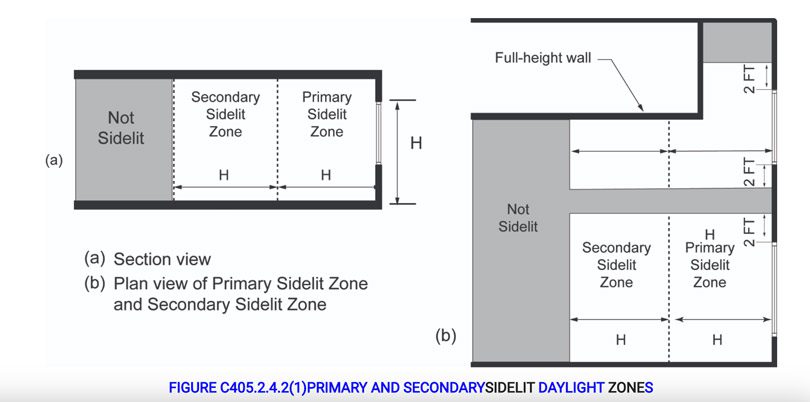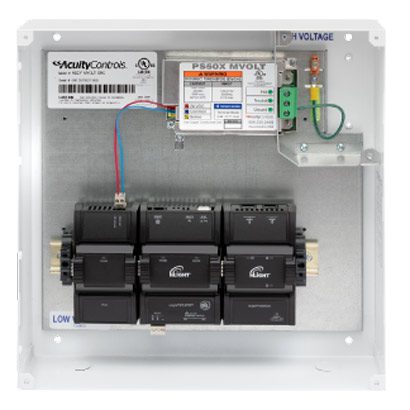By Carl Canfield
Hi, I’m Carl Canfield from the TLA Controls Sales Team – welcome to the October Tech Corner! Summer has wound down (already!?), and as we approach the cozier, quieter months it’s important to take a moment to contemplate the important things in life – friends, family, and the latest installment of IECC energy code for commercial buildings.
That’s right, it’s not just any Fall, it’s Fall 2021 which means the latest version of everyone’s favorite energy code has been published, and jurisdictions are adopting it faster than you can calculate the extents of the secondary daylight zone.
Secondary daylight zone!? Don’t panic. TLA is here to highlight what’s new for 2021, and help you understand how to specify a compliant lighting and control system.
Occupant sensor controls
Occupancy sensors continue to be one of the main tools in a designer’s toolbox to achieve code compliance and automatic lighting shut off. For 2021, occupant sensor requirements have been expanded and clarified, with sensors now required in corridors in addition to the many other mandatory spaces.
Corridor functional requirements:
- Lights may automatically come on to full. After no more than 20 minutes, reduce output by at least 50%.
- Lights shall turn off by sensor or timeclock.
Sensor requirements in warehouses and open offices have been further expanded. Check the code text for details on these updated requirements.
Designer note
Did you know that full automatic-on controls with no manual control are allowed in corridors, parking areas, restrooms, and lobbies, among others?
Click here to learn more about Acuity’s nLight sensor and control system products—the perfect system to achieve all code requirements.
Did you know? A study published by the Northwest Energy Efficiency Alliance and DesignLights Consortium found that building with luminaire level lighting controls saved an average of 28% more energy from lighting than buildings without! Click here and see below to learn more.
Time-switch controls
Time-switch, or “timeclock”, requirements are largely unchanged for 2021 – any spaces not controlled by occupant sensors must be turned off by a timeclock.
Designer note
The ultimate networked lighting system controller, the nLight Eclypse, provides timeclock scheduling and much more to an entire building (or campus!) of connected devices. Click here to learn more.

Pictured above: nLight Eclypse Controller
Have a small project? Try nLight’s elegant nDTC stand-alone digital timeclock. Connect up to 127 nLight devices via a Cat5 daisy chain and, just like that, you have a fully compliant timeclock system. Click here to learn more.

Pictured above: nLight nDTC Digital Time Clock
Light-reduction controls
Light-reduction, or dimming, controls are now required where occupancy sensors are not provided. This section has been extracted from the time-switch controls section, where it was in 2018, and promoted to its own section.
Designer Note
There are a few notable exceptions where dimming is not required, so check the Code text carefully to avoid over-designing this potentially costly control measure.
What’s the best way to dim site lighting, high bay lighting, or parking garage lighting where long cable runs add cost and reduce dimming performance? Embed the controls right in the fixture. Click here to find out more.
Daylight-responsive controls
IECC 2021 has taken a page from of ASHRAE 90.1 and Title 24 and now requires separate and independent control for secondary daylight zones, in addition to the previously required primary daylight zones.
What is a secondary daylight zone? Well, if we’re talking about side-lit zones (i.e. window daylight zones), and the depth of the primary daylight zone is equal to the height from the floor to the top of the window, H, then the secondary daylight zone is just another H feet.

Pictured above: Figure C405.2.4.2(1) from IECC 2021
Typical spaces where you may find this requirement include open offices, classrooms, cafeterias, gymnasiums, lobbies, etc.
Designer Note
Not sure where or how many daylight sensors and dimming channels to provide? Eliminate the guesswork and rat’s nest of wiring by specifying all open area lights with luminaire level lighting controls (LLLC).
All the control you need is built into the fixture. Click here to learn more.

Pictured above: Lithonia BLT with embedded nLight Air sensor
Automatic receptacle control
A major addition to IECC for 2021, automatic receptacle control, or “plug load control”, is now required by all three major U.S. energy code publishers (IECC, ASHRAE 90.1, and CA Title 24).
The major provisions of this section include:
- 50% of receptacles in offices, conference rooms, copy/print rooms, break rooms, classrooms, and individual modular workstations, and at least 25% of branch circuit feeders for modular furniture shall be controlled to automatically de-energize via occupant sensors (after a 20 min timeout), or a time clock, or a signal from a third-party control or alarm system like the BAS or fire alarm systems.
- To comply with the 50% controlled plug requirement, provide either a split-face receptacle with the top outlet being controlled and marked per NEC requirements or a controlled plug within 12” on the wall of any uncontrolled plug.
Designer Note
Make plug load control simple with a 20A nLight wired or wireless plug load controller. Click here for information on wired, and here for wireless.
Energy Monitoring
Another major addition for IECC 2021, all new projects greater than 25,000 sq-ft must now provide energy sub-metering, monitoring, and reporting of the building’s energy end-use categories.
Major energy end-use categories include:
- Total HVAC, interior lighting, exterior lighting, plug loads, process loads, and building operation / miscellaneous loads.
Meters must be provided with an accuracy of +-2%, and an overall data acquisition system must be provided capable of hourly interval reporting, total data storage for at least 36 months, and graphical reporting of the data for end-user review.
Conclusion
This cycle of IECC has introduced several new energy and design requirements that require informed and diligent designs while updating and refining many existing sections and requirements.
The Lighting Agency continues to be here for our local engineering and design community to help you produce high-quality designs and specifications while staying in touch with the world of manufacturers and products.
Please do not hesitate to reach out to any of our expert controls sales staff to schedule a lunch and learn on code, or product, or whatever controls topic you want to learn more about.
Rob Pries, RPries@thelightingagency.com
Nick Berry, NBerry@thelightingagency.com
Carl Canfield, CCanfield@thelightingagency.com
Stay bright!
Carl
Need to know more? Our Controls Team is here to help. Drop us an email with your requests for future Tech Corner posts!
PS We’re back in the office on a limited schedule. Email your TLA Sales Rep, or send us an email at getinfo@thelightingagency.com to make an appointment to see us in person.
We want to hear from you! Do you have questions about upcoming events, or have an event that you’re hosting that we should know about? Email information to Dawn at dwebber@thelightingagency.com
Be sure to bookmark our EVENTS page where you can access and register for scheduled and ongoing virtual presentations, seminars, and trainings for a full spectrum of lighting topics ranging from controls, to design, to products.
Need pricing info now to meet your deadline? Try our new QUICK QUOTE TOOL – designed to help designers stay on budget.
Are you looking for an efficient way to stay current on all things lighting? Subscribe to the TLA monthly newsletter.
The Lighting Agency is a local construction allied company representing the premier lighting and controls manufacturers for Colorado and Southern Wyoming. We strive to be an integral part of the design process through our work with lighting specifiers, contractors, suppliers, and owners to create brilliant yet budget-sensitive results for projects big and small.


